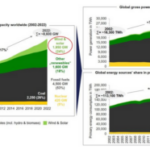October 8, 2024 Global Warming
Clearly, the only sources that can keep electricity affordable for everyone are fossil fuels and nuclear power.
Fossil fuels help withstand intense tropical heat

Fossil fuels help people cope with the sweltering heat of Asia’s scorching summers.
In densely populated metropolitan areas, air conditioners and ceiling fans powered by electricity generated from fossil fuels are essential to the well-being of millions of people living in these tropical areas, where urban infrastructure, which often lacks air intakes or windows and is particularly dense with buildings and skyscrapers, exacerbates the so-called heat island effect, in part and especially because of the rampant use of air conditioners that release heat outdoors to cool homes.
As we all know, summer in Southeast Asia is characterized by high temperatures and especially high humidity.
As a result, this season is characterized by a significant increase in electricity consumption.
For example, in the first quarter of 2024, India experienced a significant increase in coal-fired power generation, reaching an unprecedented level of 9% higher than the previous year.
This increase was mainly due to increased demand for electricity as a result of the scorching weather.
Recently, India has also increased its reliance on natural gas.
“With the surge in electricity demand due to rising temperatures, the power sector has witnessed an increase in the use of natural gas and particularly LNG to meet demand”, said a note from S&P Global.
But despite the unprecedented increase in coal capacity, the country still faces a new energy crisis this year.
One of the most likely reasons is an unwarranted reliance on renewable energy, which not only diverts critical investment away from fossil fuels, but also makes grid management less reliable when electricity demand is high.
Wind and solar power, often touted as the future of energy, reveal their obvious limitations just when they are needed most.
In fact, wind power generation always requires absolutely optimal conditions – winds that are neither too weak nor too strong.
Similarly, solar power generation always requires clear skies.
As a result, neither generation system can provide a constant supply of electricity, let alone meet sudden surges in demand.
In addition, both systems require expensive infrastructure and a supply of backup electricity generated from “traditional” sources.
Additional costs are added to consumers’ bills.
In short, both solar and wind reduce reliability and increase costs.
The same is true of hydropower.
Many hydroelectric plants depend on river flows that are sustained by seasonal rainfall.
In tropical climates, the dry season often results in lower water levels in major rivers and/or lakes, reducing the capacity to produce electricity.
Coal-fired power plants also have the advantage of being able to be turned on and off, even temporarily, to meet fluctuations in electricity demand.
To meet the growing demand for energy, nations around the world would have to abandon major investments in solar and wind power.
Fossil fuels, along with nuclear power, have clearly proven to be the only sources that can keep electricity affordable for all.














